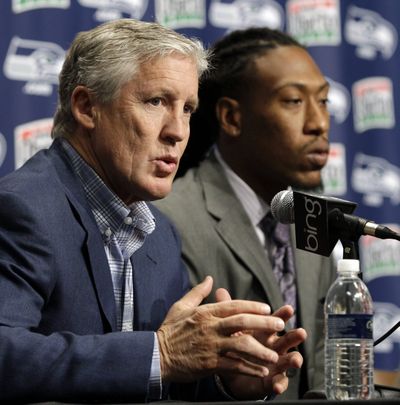Seahawks justify their pick

The Seahawks’ turn to pick was approaching in the first round of the NFL draft on Thursday when general manager John Schneider experienced something that plenty of people can undoubtedly identify with.
He wasn’t hearing Bruce Irvin’s name, and that got Schneider real nervous, just not for the reason you think.
This had nothing to do with the belief of some people that Irvin didn’t warrant more than a second-round selection or the fact the Seahawks kept their interest in Irvin in whisper mode.
Schneider worried because other teams weren’t making a peep about Irvin.
No one was trying to see if Seattle had eyes for Irvin. Nobody was mentioning Irvin as a guy they wanted, either, which had Schneider’s Spidey sense at full tingle as the Seahawks decided to pull the trigger and pick Irvin at No. 15.
“We just didn’t want to get too cute,” Schneider said after that first round, wearing a dress shirt he’d sweated through. “This guy is just too special of a football player.”
It was the most surprising selection in the first round of this draft, a choice that had ESPN’s Mel Kiper expressing bewilderment and a city of fans in Seattle howling, “Who?”
The Seahawks pulled off a shocker all right, a choice that has been questioned locally and derided nationally. Kiper gave the Seahawks a C-minus, the lowest grade he awarded to any team after the draft, and rated Seattle a D-minus in terms of value, largely based on his evaluation of Irvin.
“We’re still talking about a player I had a late second-round grade on,” he wrote.
The Seahawks obviously had a much different evaluation. Not only did they take Irvin in the first round, but he was the first pass rusher selected in the draft. Seattle looked at a position group that included Melvin Ingram of South Carolina and Quinton Coples of North Carolina and the Seahawks decided Irvin was the one they really wanted.
Does it mean that selection was the best one? Of course not. Only time will tell who turns out to be most productive, and maybe Kiper’s analysis is spot on. But the fact the Seahawks’ selection is denigrated nationally because it did not conform to the predraft pecking order says more about the uninformative nature of postdraft grades than it does about Seattle’s selection.
Owner Paul Allen doesn’t have Schneider as general manager so he can work off Kiper’s opinion and national consensus. He has Schneider in charge of the draft to amass the best team possible, and we now have three years of evidence that shows Schneider and these Seahawks believe the best way to do this is to keep a tight lid on their draft-day targets.
It was true last year when Seattle chose Alabama tackle James Carpenter in the first round, a player no one predicted the Seahawks would target with that pick. It was true again this year with regard to Irvin, but it goes beyond the top-shelf selections. Seattle picked wide receiver Kris Durham in the fourth round in 2011, someone who was not among the more than 300 players invited to the national scouting combine. It picked two more non-combine invitees this season: linebacker Korey Toomer in the fifth round and defensive end Greg Scruggs in the seventh.
Seattle doesn’t tip anyone off to potential draft targets.
But as stealthy as Seattle tries to be, there’s the reality that there are 31 other NFL teams poring over the same array of potential employees looking for the same kind of impact players, which brings us back to Thursday night in Seattle’s draft room and Schneider’s worry others were positioning themselves to pick Irvin.
Think Seattle could have gotten Irvin a little bit later? The Seahawks were hoping to heading into the draft, thinking they might be able to trade back and still take him perhaps in the 20s.
Was Irvin going to be available in the second round where people like Kiper had him graded? Doubtful. ProFootballTalk.com reported that seven different teams had Irvin graded among the top 15 prospects in the draft, and longtime NFL reporter Len Pasquarelli – who now works for The Sports Xchange – listed the Bears, Jets, Packers and 49ers as teams interested along with the fact San Francisco worked Irvin out just last week.
All that brings into clearer focus the choice Seattle faced Thursday as the 15th pick approached. No one was talking about Irvin, which had Schneider worried because he knew there were other teams interested.
And it wasn’t long after Seattle picked Irvin that the Seahawks heard the Jets would have taken him with the next choice if he was available.
Was it the right pick? We’ll have to wait and see. For now, all we know is that Seattle got the player it really wanted. For better or worse.